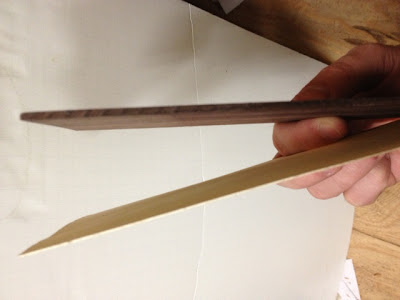So here is the next set of progress photos. You can see the scarf joint all glued up at this point:
And here is a closeup. Notice the overhang on the top of the headstock. That portion is going to be removed via bandsaw and then planed even and flat. I drew the line you see on the side of the headstock at 18mm from the back of the headstock so that I would have a reference point when sawing and planing. Here is the closeup with the line drawn:
I feel like this next picture is of some sort of scene in a movie portraying the impending doom of a canoe fast approaching a waterfall, except that it is wood fast approaching a band saw...
Tah dah! A nice, uneven band saw cut. To the handplane!
(Note that I did not cut on the line, but right above it, to give me room to plane to the correct depth. This is a better way to get more exact results, and makes the uneven cut a non-issue)
Because I do not have a fancy woodworker's bench, with all of the holes for benchdogs and nice built in vices for clamping complex wood projects, I clamped the neck to my router table. To support the headstock, I put a saw horse with a wood block on it under the end of the headstock, and slid a wedge of wood up until it was tight (but not so much force that I might break the headstock). I then proceeded with the planing.
Notice the line where the two glued up pieces of wood come together on the headstock. It helped me when planing to refer to this line, because I could tell when things were flat and true (when the line was straight, and not wavy). I also drew a square line near the beginning of the headstock to use as a reference for my planing (you can see it near my fingers). After a few minutes (60?) I had the final thicknessed product.

Then, I needed to get rid of some of the extra wood on the neck blank to get the neck to the right length. I did some approximate (but very precise too) measurements for where the 12th fret would land (the 12th fret being exactly half the distance between the nut and the saddle, which is why you can get natural harmonics on a guitar string at this location), and added an inch for the part of the neck inside the body (classical guitar thing). I then drew a line, and cut off the excess, which I will use to stack up and glue together for the heel (to be seen in the near future).
Note: it is always good to mark the orientation of the board you just cut, in case you want to refer later to which direction the grain was traveling and what side of the board was facing which way. This is why I marked it with the diagonal line you see and made a little note on the board.
All for now!

































